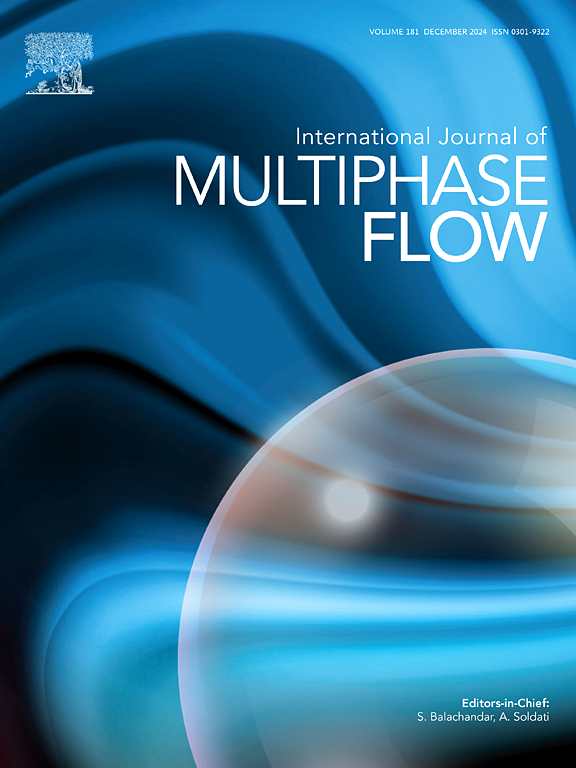摇摆生物反应器流体运动和传质的计算模型及其在养殖肉制品生产中的应用
IF 3.8
2区 工程技术
Q1 MECHANICS
International Journal of Multiphase Flow
Pub Date : 2025-08-05
DOI:10.1016/j.ijmultiphaseflow.2025.105375
引用次数: 0
摘要
摇摆或波浪混合生物反应器因其一次性、低运行成本和可扩展性而成为养殖肉类生产中有前途的创新。然而,尽管有这些优点,摇摆生物反应器的性能并没有很好地表征,因为它们在市场上的历史相对较短,而且几何和操作参数的范围很广。在本研究中,我们为这个多相、多物理场系统开发了一个严格的计算框架,以定量评估在不同操作条件下矩形摇摆生物反应器内的混合、氧传递和剪切应力。该框架使用Basilisk开源平台实现。我们使用二阶有限体积Navier-Stokes求解器和体积-流体界面重构方案来精确求解高度非线性的流体运动。通过求解多流体系统的平流-扩散方程,研究了不同操作条件下的混合时间和氧传质系数(kLa),两者都显示了瞬时层流背后的稳定流的强烈关系。我们进一步强调了两个关键的流体动力学现象,显著影响生物反应器的性能。首先,我们研究了从层流到湍流的过渡状态。此外,我们确定了触发生物反应器内共振的特定操作条件,增强了混合和氧气传递。最后讨论了剪应力和能量耗散率对细胞存活的潜在影响。我们的研究结果有望为设计优化的生物反应器提供有价值的见解和指导,以支持下一代养殖肉类工业管道。本文章由计算机程序翻译,如有差异,请以英文原文为准。

Computational modeling of fluid motion and mass transfer in a rocking bioreactor with application to cultivated meat production
Rocking or wave-mixed bioreactors have emerged as a promising innovation in the production of cultivated meat due to their disposable nature, low operating costs, and scalability. However, despite these advantages, the performance of rocking bioreactors is not well characterized in view of their relatively short history in the market and the wide range of geometrical and operating parameters. In the present study we develop a rigorous computational framework for this multiphase, multi-physics system to quantitatively evaluate mixing, oxygen transfer, and shear stress within a rectangular rocking bioreactor under various operating conditions. This framework is implemented using the Basilisk open-source platform. We use a second-order finite volume Navier–Stokes solver and a volume-of-fluid interface reconstruction scheme to accurately resolve the highly nonlinear fluid motion. By solving the advection–diffusion equation for a multi-fluid system, we examine mixing time and the oxygen mass transfer coefficient () for different operating conditions, both of which show a strong relationship with steady streaming underlying the instantaneous laminar flow. We further highlight two critical hydrodynamic phenomena that significantly influence bioreactor performance. Firstly, we investigate the transitional regime from laminar to turbulent flow. Moreover, we identify specific operating conditions that trigger resonance within the bioreactor, enhancing mixing and oxygen transfer. We finally discuss the potential effects of shear stress and energy dissipation rate on cell survival. Our findings are expected to provide valuable insights and guidelines for designing optimized bioreactors to support the next-generation cultivated meat industry pipelines.
求助全文
通过发布文献求助,成功后即可免费获取论文全文。
去求助
来源期刊
CiteScore
7.30
自引率
10.50%
发文量
244
审稿时长
4 months
期刊介绍:
The International Journal of Multiphase Flow publishes analytical, numerical and experimental articles of lasting interest. The scope of the journal includes all aspects of mass, momentum and energy exchange phenomena among different phases such as occur in disperse flows, gas–liquid and liquid–liquid flows, flows in porous media, boiling, granular flows and others.
The journal publishes full papers, brief communications and conference announcements.

 求助内容:
求助内容: 应助结果提醒方式:
应助结果提醒方式:


